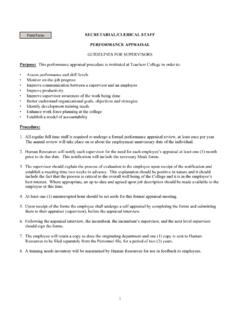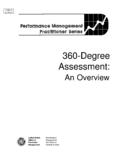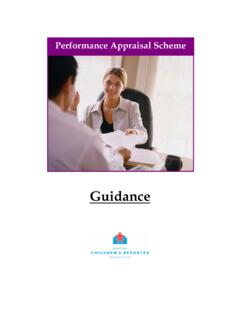Transcription of PERFORMANCE APPRAISAL POLICY - Employ My Ability
1 EMA Policies / EMA. PERFORMANCE APPRAISAL POLICY . Introduction This POLICY provides a guide to employees on the purpose of the PERFORMANCE APPRAISAL and to ensure that the work PERFORMANCE and training needs of every employee are managed effectively and fairly. While this POLICY applies to all employees of Employ My Ability (EMA), there may be some cases where the process is amended so that it is appropriate to the role. POLICY A PERFORMANCE APPRAISAL gives individual employees and their manager an opportunity to review PERFORMANCE , work content, loads and volume, to look back on what has been achieved during the past year then agree future objectives. It is also the time an employee can agree personal objectives, and any learning and development requirements which may help.
2 The APPRAISAL system is designed to: Be a positive process. Raise the quality of services provided by motivating. Increase job satisfaction. Identify appropriate training and development requirements. POLICY aims EMA recognises that employees perform most effectively when they have clear expectations of their job role and purpose, their own targets or objectives, and of the wider aims of EMA. The POLICY aims to ensure that employees: Know what is expected of them the required standard of PERFORMANCE and how they should do their jobs. Receive feedback which aims to improve and develop PERFORMANCE and recognise their achievements. Identify areas where improvement is required and training and development needs.
3 Have a mutually agreed plan to achieve both development goals and employee career development. Roles and Responsibilities EMA is responsible for: Setting sustainable standards. Providing advice and guidance to managers on implementing the POLICY . Ensuring that appropriate training and development is available for managers and employees. Holding an APPRAISAL meeting and an APPRAISAL review each year. Appraising employees in a fair and objective manner against agreed objectives and action plans. Following up actions arising from appraisals. Ensuring that a written record of the APPRAISAL meetings is completed. Informing employees how the APPRAISAL scheme works and how it will affect them.
4 Managers are responsible for: Ensuring each member of staff in their team is clear about what is expected of them. Ensuring that new employees have work targets and objectives set as part of induction. Meeting employees on a regular basis to review progress. Employees are responsible for: Taking an active role in reviewing their PERFORMANCE APPRAISAL and target setting. APPRAISAL Process Self- assessment Employees must be informed of the APPRAISAL at least 4 weeks before the APPRAISAL one-to-one meeting. A copy of the APPRAISAL self- assessment form should be given to the employee so the employee has an opportunity to contribute. A copy of the completed self- assessment form should be returned to the manager 1 week before the APPRAISAL one-to-one meeting.
5 APPRAISAL PERFORMANCE The manager will use the APPRAISAL PERFORMANCE checklist to prepare for an APPRAISAL meeting by considering what criteria to use to measure employee PERFORMANCE this will set the measure for PERFORMANCE over the next year. The one to one meeting The APPRAISAL one-to-one meeting will be carried out in private so as to provide for confidentiality. Sufficient time will be allocated so that the meeting is unhurried and any discussion is properly considered. However, it must be understood by the employee and the manager that information discussed in an APPRAISAL may need to be disclosed to others. The one-to-one form should be used to record an employee / manager meeting.
6 The manager should complete this form at, or immediately following the meeting, ensuring that it is signed by both themselves and the employee . A copy will be given to the employee . The APPRAISAL Record When an APPRAISAL is completed, it should be recorded using the APPRAISAL form . This form should be completed by the appraiser and countersigned by the employee and the appraiser's manager so the employee is aware of the competencies that are critical for effective PERFORMANCE of that role. A copy of the form should be given to the employee as soon as possible. 2. Employees may use as a last resort EMA grievance procedure to resolve problems as to the accuracy or the fairness of the APPRAISAL .
7 Non Compliance All employees have a role to play in enforcing the POLICY and are required to deal with any observed or reported breaches. Should employees feel apprehensive about their own safety in regard to addressing any breach, they should seek senior management support. Failure to comply with this POLICY may lead to a lack of clarity over job role, learning needs or expected standards of PERFORMANCE , resulting in reduced effectiveness or efficiency, underperformance and putting service delivery at risk. Any member of staff refusing to observe the POLICY will be liable to disciplinary action in accordance with EMA 's Disciplinary POLICY up to and including dismissal.
8 Implementation of the POLICY Overall responsibility for POLICY implementation and review rests with EMA senior management. However, all employees are required to adhere to and support the implementation of the POLICY . EMA will inform all existing employees about this POLICY and their role in the implementation of the POLICY . They will also give all new employees notice of the POLICY on induction to EMA . This POLICY will be implemented through the development and maintenance of procedures for appraisals and one-to-one meetings, using template forms, and guidance given to both managers and employees on the process. Monitoring POLICY The POLICY will be monitored on an on-going basis, monitoring of the POLICY is essential to assess how effective EMA has been.
9 Reviewing POLICY This POLICY will be reviewed and, if necessary, revised in the light of legislative or codes of practice and organisational changes. Improvements will be made to the management by learning from experience and the use of established reviews. POLICY Amendments Should any amendments, revisions, or updates be made to this POLICY it is the responsibility of EMA senior management to see that all relevant employees receive notice. Written notice and/or training will be considered. Additional Information If you require any additional information or clarification regarding this POLICY , please contact your manager. In the unlikely event where you are unhappy with any decision made, you should use EMA 's formal Grievance Procedure.
10 To the extent that the requirements of this POLICY reflect statutory provisions, they will alter automatically when and if those requirements are changed. 3.








